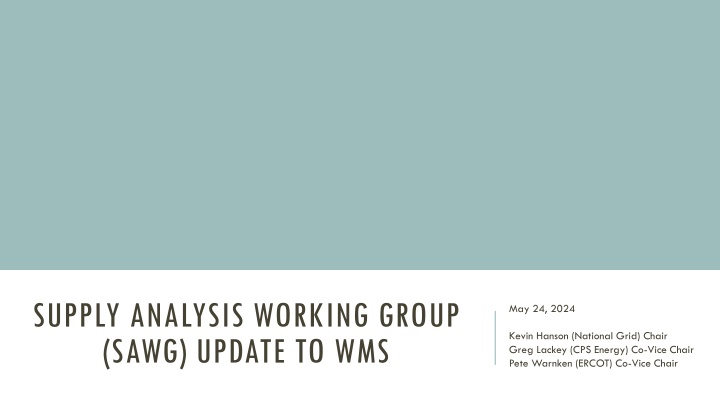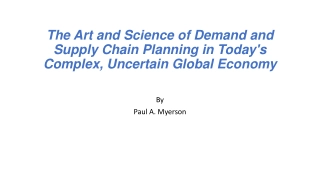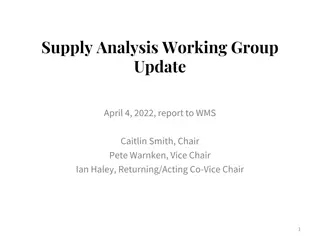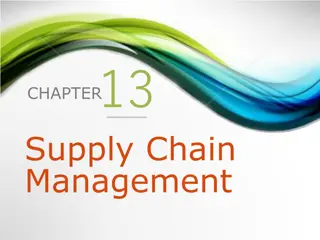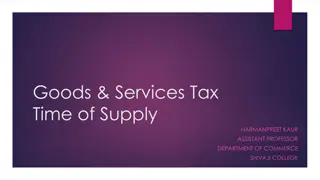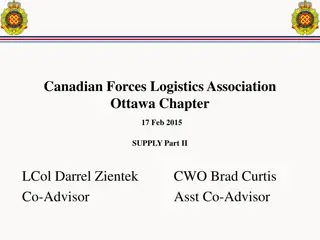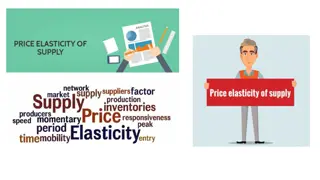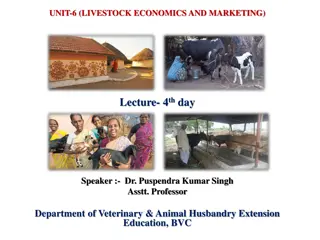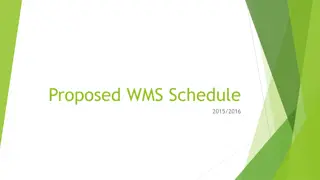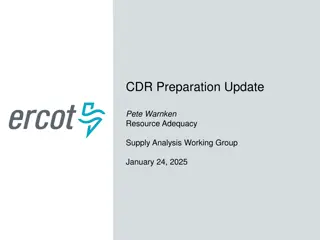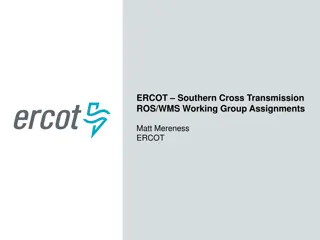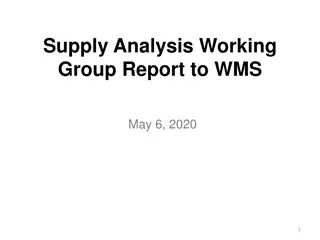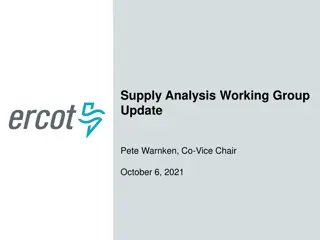Supply Analysis Working Group Update to WMS May 24, 2024
Chair Kevin Hanson from National Grid along with Vice Chairs Greg Lackey, CPS Energy, and Pete Warnken, ERCOT, lead the SAWG meeting with a focus on new battery storage methodologies, draft cost of new entry results, and upcoming tasks in the CONE study. The agenda includes discussions on ELCC methodology, CDR NPRR updates, reliability standards, and more for the May 2024 session.
Download Presentation

Please find below an Image/Link to download the presentation.
The content on the website is provided AS IS for your information and personal use only. It may not be sold, licensed, or shared on other websites without obtaining consent from the author.If you encounter any issues during the download, it is possible that the publisher has removed the file from their server.
You are allowed to download the files provided on this website for personal or commercial use, subject to the condition that they are used lawfully. All files are the property of their respective owners.
The content on the website is provided AS IS for your information and personal use only. It may not be sold, licensed, or shared on other websites without obtaining consent from the author.
E N D
Presentation Transcript
SUPPLY ANALYSIS WORKING GROUP (SAWG) UPDATE TO WMS May 24, 2024 Kevin Hanson (National Grid) Chair Greg Lackey (CPS Energy) Co-Vice Chair Pete Warnken (ERCOT) Co-Vice Chair
SAWG AGENDA MAY 2024 New Battery Energy Storage ELCC Methodology Study Draft CONE Study Results CDR NPRR Update Reliability Standard and VOLL Survey Status Summer Outlook/CDR Overview and Q&A
NEW BATTERY ELCC METHODOLOGY ASTRAPE Consulting presented on the study Purpose of the study: To investigate a methodology to generate marginal ELCCs by technology for 2 non-dispatchable technologies (e.g. 0-75GW Solar PV, 0-75GW Wind) and unlimited combinations of storage duration (X GW of 2 Hr Battery, X GW of 4 Hr Battery, X GW of 8 Hr Battery) Proposal : simplify the problem by leveraging SERVM to produce numerous LOLE Events for combinations of solar and wind at 0.1 LOLE, and utilizing out of model approach to establish storage value for each portfolio 3
DRAFT COST OF NEW ENTRY RESULTS Brattle presented the ERCOT CONE Study Draft CONE represents the first-year revenues a resource would need to enter, given its costs, its projected future net revenue trajectory, and its cost of capital. Cost estimates are a bottom-up method of development of the Capital and O&M costs for the reference technology Reference technology is an aeroderivative LM6000 in Harris County The alternate reference technology is a Solar PV + BESS Hybrid (200 MW PV + 100 MW 2-hr BESS in Brazoria County 5
DRAFT COST OF NEW ENTRY RESULTS The calculated cost of New Entry will be presented at next meeting. Calendar Month Start of Week Jan Feb Mar Apr May Jun 1 8 15 22 29 5 12 19 26 4 11 18 25 1 8 15 22 29 6 13 20 27 3 10 17 24 CONE STUDY Task 1: Selection of Thermal Dispatchable Technology Task 2: Selection of Alternative Reference Technology Task 3: Develop Cost Estimates Task 4: Determine Financial & Cost Escalation Parameters Task 5: Briefing on Assumptions Task 6: Calculate CONEs Task 7: Draft CONE Study Report Task 8: Excel Workbook & Final CONE Study Report Task 9: CONE Study Presentations D F D F Draft Deliverable Final Deliverable Completed In progress Not started 6
CDR NPRR UPDATE Pete Warnken of ERCOT presented on the CDR NPRR Based on feedback from Supply Analysis Working Group participants, ERCOT recommends changes to proposed new Section 3.2.6.2, Effective Load Carrying Capability (ELCC) Studies, and proposed new language in Section 3.2.6.4, Total Capacity Estimates. The changes (1) remove the word annual from average ELCC references to clarify that seasonal ELCC values will be used in the Report on Capacity, Demand and Reserves in the ERCOT Region (CDR), and (2) removes the ESR design duration class definitions. This latter change reflects a new ELCC calculation methodology that will not require the specification of such class definitions. 7
RELIABILITY STUDY UPDATE May 16 PUC Open Meeting: Commissioners agreed to adopt the proposal 0.1 Frequency (Expected loss-of-load event once every 10 years) 12-hour maximum duration with 1% exceedance probability Maximum magnitude determined by ERCOT analysis of the load shed that can be safely rotated during an event, along with a 0.25% exceedance probability Exceedance value to be updated on a schedule determined by the Commission Commission seeking stakeholder input on an appropriate value Initial review of the Reliability Standard starting in January 2026 (to align with market design review), and every five years thereafter Request to provide the normalized Expected Unserved Energy (EUE) as another data point (EUE divided by system load) 8
VALUE OF LOST LOAD (VOLL) SURVEY VOLL Survey closed for most customers on May 17th but will remain open for additional responses from certain large commercial & industrial customer classes until May 31st Strong response rates from residential and small/medium sized commercial customers Large industrial response rate likely to be ~30% of 100 response target; working with AEP Texas on sharing responses from their VOLL survey Next Steps: reviewing and analyzing survey data with a final VOLL Report expected by end of August 9
CDR OVERVIEW Released on 5/24/2024 Discussion addressing the solar contribution to peak showing zero beginning in CY 2028 due to peak moving to later hours Discussion around the possibility of adding the hour of the forecasted peak load Additional information included for new contracted and non-contracted loads 10
